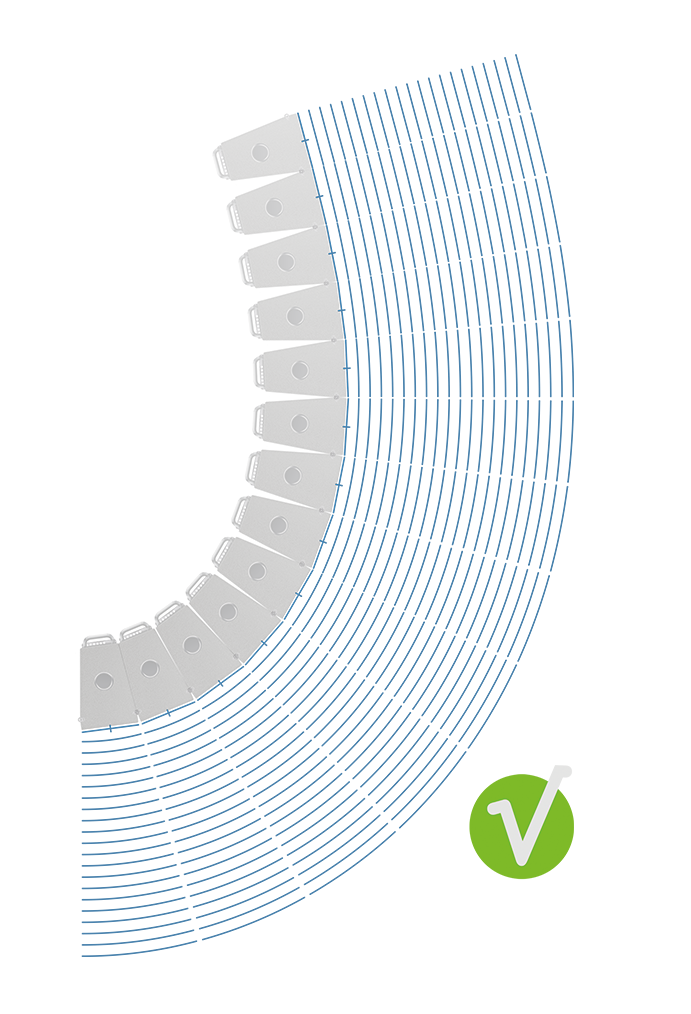VALTEC™.
Variable Acoustic Lens Technology
“How nice it would be if the vertical dispersion angle of a single Line Array element could be adjusted.”
As many engineers and users of Line Arrays know, the standard vertical dispersion angle of a single element causes problems, especially when the angle between elements is 0°. The overlap between the elements causes destructive interference in the HF range. At a greater distance (far-field), this effect gets bigger. Then elements even radiate in the area of elements that hang much higher or lower in the array and visa versa.
In the HF range where the distance between amplitudes is already small. This incorrect phase alignment causes a diffuse sound image and it creates a comb filter effect. This means that different frequencies are extinguished depending on the distance of the listener tot the source. This has a very detrimental effect on the correct experience of music and speech.
VALTEC™.
VALTEC™ makes it possible to control and adjust the vertical dispersion angle, called vertical "beam steering", of an High Frequency driver/waveguide.
For this, two variable lenses work in succession with an accurate waveguide to control the curving of the wavefront which then leads to a wider or narrower dispersion beam.
In addition, with a pair of extra lenses, it is also possible with VALTEC™ to steer the beam and give it a direction, more upwards or more downwards, up to 30°.
VALTEC™ in Line Arrays.
VALTEC™ AND LINE ARRAYS
In this video we explain why a correct beam angle makes a Line Array the perfect point source, with VALTEC™ it can be done.
VALTEC™ applied in Line Arrays makes it possible to adjust the vertical radiation in wider or narrower, even down to 0°. For this purpose, by means of the two VALTEC™ lenses, the wavefront is variably curved to even a plane wave which results in a 0° dispersion angle and a typical cylindrical radiation behavior. This radiation behavior of 0° is important for a Line Array because it is most commonly used.
At 0° the wavefront is a plane wave with no vertical dispersion. This not only means that there are no destructive interference between the elements that operate directly under eachother
at 0°, multiple elements below each other with a plane wavefront results in a continuos plane wavefront over the entire array resulting in a coherent cylindrical radiation behavior.
Another important result of the VALTEC™ technique is the minimization of the comb filter effect. Because overlapping sinewaves do not have a phase shift with VALTEC™, they don't cancel each other out anymore. This constructive interference results in an average higher SPL, especialy at greater distances. The VALTEC™ Line Array behaves as a true point source with cylindrical dispersion.
Usually a Line Array is bent more at the bottom to create a larger opening angle. Here the side effect is that the cylindrical radiation pattern turns into a more spherical radiation behavior resulting in a lower SPL in the HF range. Because this part usually radiates in the nearfield, this is a positive side effect.
However, using VALTEC™ and so the exact vertical radiation angle associated with the mechanical curvation of the Line Array element the wavefront as a total remains coherent which leads to a much more accurate sound reproduction.
With the VC LINE, the vertical dispersion can be adjusted ac- cording to the splay angle between the individual elements, creating a seamless connection between the wavefronts of the elements. The result is a homogeneous wavefront and no comb filter effect.
With conventional line arrays, the non-adjustable vertical dispersion leads to an overlap of the wavefront at all splay angles except the angle corresponding to the nominal vertical dispersion, in our example 10°. This leads to a phase shift within the wavefront, which in turn leads to the dreaded comb filter effect. If the splay angle exceeds the nominal angle (if the enclosure allows this), imperfections in the wa- vefront occur. This leads to dips in the frequency response.







